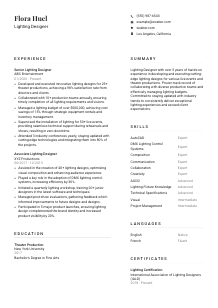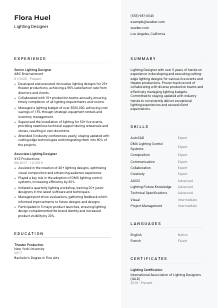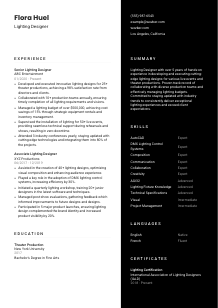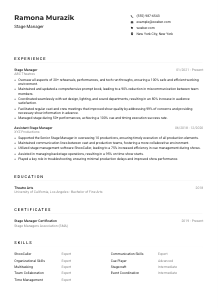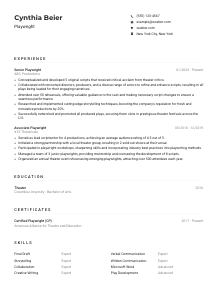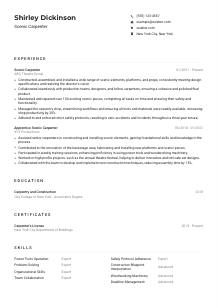Lighting Designer Resume Example
Shaping stage atmospheres, but your resume is dim? Illuminate your credentials with this Lighting Designer resume example, created using Wozber free resume builder. Discover how to radiantly align your luminary talents with job specifications, making your career journey as luminous as the spotlight!

How to write a Lighting Designer resume?
Hello, creative luminary! The path to lighting up stages and spaces with your design genius starts with one crucial step – crafting a resume that shines as brightly as your work. With the free resume builder Wozber, you're equipped to tailor a document that not only captures your unique talents but also speaks directly to the heart of the job you're vying for.
Focused on the fine art of landing a Lighting Designer position, this guide is your companion in fine-tuning your resume into a narrative as compelling as your designs. Let's illuminate your career path together!
Personal Details
In the world of lighting design, first impressions are everything. Your resume's personal details are no exception. This section sets the tone, so let's ensure it communicates your worth from the get-go.
1. Lead with Your Name
Think of your name as the marquee at a grand opening. Make it prominent and memorable. A larger font size could do the trick, setting the stage for the professional masterpiece that follows.
2. Clarify Your Role
Positioning "Lighting Designer" prominently below your name isn't just about clarity; it aligns your professional identity with the job at hand. It also signals to the ATS that you're a direct match for the role.
3. Ensure Contact Info Is Spot-On
Your phone number and professional email play leading roles here. Triple-check for accuracy and opt for a simple, professional email format. Missteps in this act could mean a missed curtain call for job opportunities.
4. Location, Location, Location
"Los Angeles, California" isn't just where you're based; it's a match for the job's requirements. Mentioning this ensures you're already ticking boxes on the employer's checklist, minimizing any concerns about relocation.
5. The Optional Marquee
A professional website or portfolio can be your spotlight, offering a live preview of your projects. Though optional, it reinforces your candidacy by showing not just telling your accomplishments.
Takeaway
Remember, your personal details are the opening act of your resume. They not only introduce you but also set the stage for the narrative to come. Keep it professional, precise, and aligned with the role for which you're applying.





Experience
In the realm of lighting design, your experience can illuminate your path to success. It's time to showcase projects that dazzled and strategies that lit the way. Let's ensure each highlight is a beam of your brilliance.
- Developed and executed innovative lighting designs for 25+ theater productions, achieving a 98% satisfaction rate from directors and clients.
- Collaborated with 10+ production teams annually, ensuring timely completion of all lighting requirements and visions.
- Managed a lighting budget of over $500,000, achieving cost savings of 15% through strategic equipment rentals and inventory management.
- Supervised the installation of lighting for 50+ live events, providing seamless technical support during rehearsals and shows, resulting in zero downtime.
- Attended 3 industry conferences yearly, staying updated with cutting‑edge technologies and integrating them into 80% of the projects.
- Assisted in the creation of 40+ lighting designs, optimizing visual composition and enhancing audience experience.
- Played a key role in the adoption of DMX lighting control systems, increasing efficiency by 30%.
- Initiated a quarterly lighting workshop, training 20+ junior designers in the latest software and techniques.
- Managed post‑show evaluations, gathering feedback which informed improvements to future designs and designs.
- Participated in 5 major product launches, ensuring lighting design complemented the brand identity and increased product visibility by 20%.
1. Dissect the Job Description
First, light up the job requirements from your prospective role. You're looking for keywords and experiences that resonate with your own. For a Lighting Designer, this might involve detailing successful theater productions or architectural projects.
2. Structure with Illumination
Illuminate your career progression with a clear, chronological layout. Start with your most recent role, offering a snapshot of your professional achievements with roles that demonstrate growth and specialization in lighting design.
3. Beam Your Achievements
Quantify your design successes where possible. "Developed and executed innovative lighting designs for 25+ theater productions" sends a stronger signal than a simple mention of responsibilities, showcasing your impact precisely.
4. Quantify with Light
When you mention managing a lighting budget of over $500,000, it not only quantifies your achievement but also highlights your capability in budget management, an essential skill in lighting design.
5. Spotlight the Relevant
Stray from the temptation to list all experiences. Instead, align your roles and achievements closely with the job description – your mastery in AutoCAD, DMX lighting control systems, or innovative design projects can do wonders here.
Takeaway
Your experience section is more than a list; it's the narrative of your journey in the lighting design world. Tailor it to shine on the aspects most relevant to your prospective role, illuminating the depth of your expertise with each bullet point.
Education
In lighting design, your education not only provides the groundwork for your expertise but also demonstrates your dedication to the craft. Let's ensure your education section shines a light on your qualifications.
1. Identify Key Educational Requirements
The job calls for a "Bachelor's degree in Lighting Design, Theater Production, or related field." Your degree in Fine Arts and major in Theater Production isn't just relevant; it's a beacon that guides the employer's decision.
2. Simplify the Structure
A clear and concise education section allows your qualifications to speak for themselves. List your degree, the field of study, and the institution, alongside the graduation date, to provide a quick yet comprehensive overview of your educational background.
3. Tailor Degree Details
For roles as specialized as Lighting Designer, the exact title of your degree can significantly impact the ATS's interpretation of your qualifications. Match it closely with the requirements to ensure a better fit.
4. Course Highlights
Though not always necessary, mentioning key courses or projects relevant to lighting design can further attest to your preparedness for the role, especially when they directly align with job requirements.
5. Other Educational Accolades
If your academic journey includes honors, relevant extracurriculars, or standout projects, briefly highlight them. This elevates the narrative of your dedication to the lighting design field beyond the classroom.
Takeaway
Your education is the groundwork of your career in lighting design. Craft this section to clearly reflect your academic achievements and specialized studies, paving the way to captivate the hiring manager's interest.
Certificates
In a profession where the landscape is ever-evolving, certifications can be the spotlight on your continuous learning and prowess in specific areas. Let's curate this section to reflect your commitment to excellence.
1. Recount the Job's Call
Though the job description did not mandate specific certificates for the Lighting Designer role, having certifications like the 'Lighting Certification' from the International Association of Lighting Designers (IALD), positions you as a remarkable candidate.
2. Handpick Relevant Certificates
Quality trumps quantity. Choose to display certifications that echo the job's demands or elevate your expertise in the field – your "Lighting Certification" is not just an accolade; it's proof of your dedication to the craft.
3. Transparency with Dates
Adding the acquisition or expiration dates of your certifications lends credibility and shows that your knowledge is current, an essential factor in fields driven by technological advancements.
4. Continuous Learning
The field of lighting design thrives on innovation and new technologies. Highlighting your commitment to ongoing learning through certifications can give you an edge, showing you're always on the pulse of the industry.
Takeaway
In a field that values precision and current knowledge, your certifications beam your commitment to remaining at the forefront of lighting design. Choose those that best showcase your expertise and adherence to industry standards.
Skills
Your skills section is like the control board of your professional portfolio. It should illuminate the technical capabilities and soft skills that make you a master of lighting design. Let's curate it to dazzle.
1. Parse the Job Posting
First, identify both the explicit and between-the-lines skills sought in the job description. Converting these into keywords aligned with your expertise is critical for ATS optimization and resonating with hiring managers.
2. Prioritize Matching Skills
From AutoCAD proficiency to an understanding of DMX lighting control systems, list skills that mirror the job description. Your adeptness in "Composition" and "Project Management" also showcases the breadth of your expertise, making you a versatile candidate.
3. Organize for Impact
Keep this section focused and organized. By showcasing skills that directly speak to the demands of the role, you make it easy for both the ATS and hiring managers to see you're the ideal fit.
Takeaway
Consider your skills section as the palette from which you'll paint your professional image. Choose colors – technical and interpersonal skills – that blend together to create a picture of the ideal candidate for the role. This detail not only aids in ATS optimization but also in ensuring hiring managers recognize your talent at a glance.
Languages
As a Lighting Designer in a cosmopolitan city like Los Angeles, your ability to communicate across cultures can be as impactful as your designs. Though the job might prioritize English, additional languages can spotlight your versatility.
1. Understand the Job's Language Preference
The requirement to be "adept in English" is your cue to rank languages with fluency levels, starting with English as "Native." This clear declaration assures prospective employers of your communication skills.
2. Showcase Your Linguistic Diversity
Additional languages, like your "Fluent" proficiency in French, add depth to your profile. They can be especially appealing in roles involving collaborative international projects or clients.
3. Align Languages with Your Experience
Integrating languages with your professional experience, especially in roles that required communication in multiple languages, can illuminate your ability to navigate diverse settings.
4. Honesty in Your Proficiency Levels
Accuracy in depicting your language skills is crucial. Whether "Native," "Fluent," or "Intermediate," your honesty sets expectations and showcases integrity.
5. Consider the Broader Context
While the job may primarily operate in English, Los Angeles' multicultural landscape makes additional languages a hidden gem in your resume, underscoring your capability to engage with a diverse clientele.
Takeaway
In the design world, effective communication is as vital as aesthetic vision. Your multilingual skills not only enhance your resume but also embody your readiness to meet the demands of a global marketplace and diverse client base.
Summary
At the apex of your resume sits the summary – a concerto of your career. It's here you harmonize your skills, experiences, and aspirations, conducting an introduction that resonates with the melody of your professional journey.
1. Decipher the Job's Symphony
Start by absorbing the essence of the roles and responsibilities listed in the job description. Understanding the rhythm of the Lighting Designer position allows you to tune your summary to the same key.
2. Lead with an Opening Note
Like the opening bars of a song, begin with a resonant statement about your profession. "Lighting Designer with over 5 years of hands-on experience" immediately sets the stage and tempo for your narrative.
3. Let Your Skills Sing
Harmonize the melody of your summary by weaving in skills and accomplishments. Mentioning your "cutting-edge lighting designs" or "allocation of a significant budget, achieving cost savings" plays a compelling tune to recruiters.
4. Compose with Brevity
Your summary is the prelude to the detailed symphony of your resume. Keep it concise and compelling, drawing the listener into wanting more.
Takeaway
The summary is where you set the stage for the narrative to unfold. It's a snapshot, a teaser of the professional saga that is you. Craft it with care, ensuring it resonates with the essence of the Lighting Designer role you aspire to illuminate.
Launching Your Lighting Designer Journey
With the tips and insights from this guide, you're ready to craft a resume that not only meets the requirements of a Lighting Designer role but showcases the unique brilliance of your career. Wozber free resume builder is your partner in this journey, offering ATS-compliant resume templates and an ATS resume scanner to ensure your resume is not just seen but truly appreciated by hiring managers. Remember, your resume is the key that unlocks the doors to opportunities.
Polish it until it shines, and step forth into the spotlight! Your next big role awaits.

- Bachelor's degree in Lighting Design, Theater Production, or related field.
- Minimum of 3 years experience in professional lighting design, with a portfolio demonstrating successful projects.
- Proficiency in lighting design software such as AutoCAD, AGI32, and Visual, as well as familiarity with DMX lighting control systems.
- Strong understanding of lighting fixtures, technical specifications, and an eye for visual composition.
- Excellent communication and collaboration skills, with the ability to work closely with production teams and clients.
- Must be adept in English.
- Must be located in Los Angeles, California.
- Develop and execute innovative lighting designs for theater, live events, or architectural projects.
- Collaborate with production teams, directors, and clients to ensure all lighting needs and visions are met.
- Manage lighting budgets, equipment rentals, and maintain inventory of lighting materials.
- Supervise lighting installations and provide technical support during rehearsals, shows, or events.
- Stay updated with industry trends, new technologies, and attend relevant workshops or conferences regularly.





